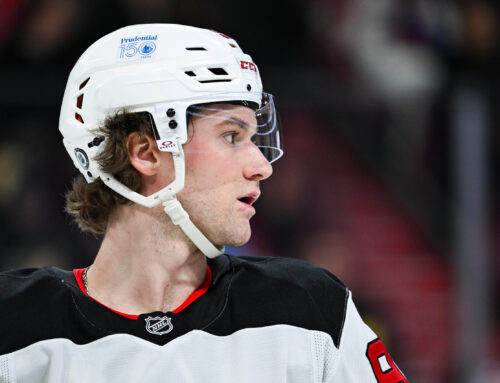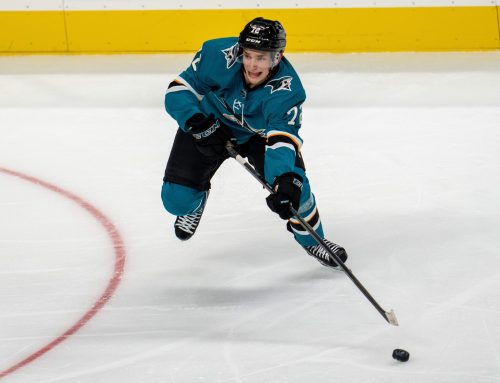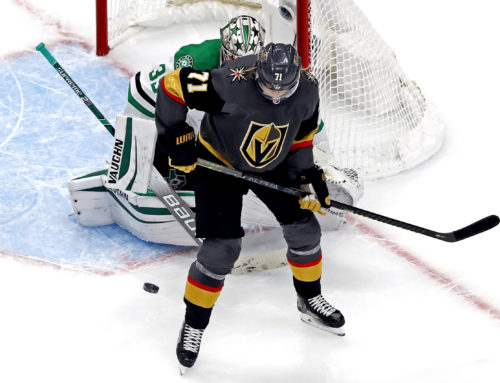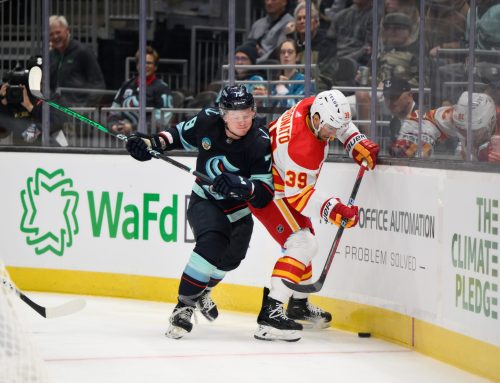
This week we get Wild, watch Patrick Kane develop chemistry with a young talent, and find a new triplet to replace Nikita Kucherov. For quick updates on the newest line combinations and the latest injury news, follow me on Twitter @BrennanDeSouza!
Nick Schmaltz – Artem Anisimov – Patrick Kane
5on5 Goals For: 11 | 5on5 Goals Against: 3 | CF%: 52.76
It looks like the line-tinkering in Chicago has led to a couple of winning combinations for Joel Quenneville, but since we talked about Brandon Saad and Jonathan Toews earlier in the season (Alex DeBrincat currently the third member of that top line!), we’ll give Patrick Kane his time in the spot light. As the above goal differential suggests, Kane, Schmaltz, and Anisimov have been doing a great job of generating more offense than their opposition (102 scoring chances for vs. 87 against).
There’s no denying Patrick Kane is a superstar, but do we really know how good he is? Over the past three seasons, he leads the league in points (259 in 225 games) with one more than Sidney Crosby (258 in 232) in seven fewer games! Kane has established himself as a point per game player, and the underlying numbers show no signs of imminent regression. His current 12.4% shooting percentage is a shade under the 14.1% he’s averaged in the past five seasons, and checking out his player profile would show all the other stats are around what we expect from him. Despite our high expectations, the stickhandling shootout specialist continues to impress.
In 2014, the Blackhawks used their 20th overall pick to draft Nick Schmaltz, a talented young player who is beginning to develop chemistry with Patrick Kane. The only real criticism of Schmaltz’s game has been a lack of selfishness, evidence of which can be found in his low shot totals. Ordinarily, failing to put the puck on net can be dangerous for a player’s production because beautiful passes don’t show up on the scoresheet. However, it’s a easier to excuse when you have Patrick Kane finishing off those sweet feeds. An example of this not working out can be found in Montreal, where Jonathan Drouin’s silky feeds go to waste with no one to finish them.
While an 18.8% shooting percentage would scream regression for most players, that scream becomes more of a whisper when you see Artem Anisimov maintained a 21% shooting percentage through 64 games last season. In my opinion, Anisimov is a pretty average player in a good situation where he’s putting up pretty average production. Is he worth streaming when Chicago has a favourable schedule? Of course! However, considering him a mainstay on your roster might be a stretch when you notice he hasn’t hit the 50-point mark in any of his eight seasons in the NHL.
Brayden Point – Tyler Johnson – Ondrej Palat
5on5 Goals For: 3 | 5on5 Goals Against 1 | CF%: 55.56
Imagine having two of your forwards lead the league in scoring. Imagine having your goaltender being an early favourite for the Vezina with his 2.11 GAA and .934 SV%. Imagine having two defensemen among the top 15 in blue line scoring, one of whom is a rookie. Now imagine, on top of all that still having more. Unlike the rest of us, Lightning fans don’t have to imagine any of this because they get to cheer on Steven Stamkos, Nikita Kucherov, Andrei Vasilevskiy, Victor Hedman, and Mikhail Sergachev every game. But what has made Tampa Bay so dangerous this season is their secondary scoring.
Brayden Point has quietly put up an amazing sophomore season with 31 points in 32 games so far. A perk of being considered ‘secondary scoring’ is that you don’t have to face the opposition’s top defensive pair and checking line. Point, Johnson and Palat have made this evident through the 35 scoring chances they have generated in their short time together, compared to the 21 they have allowed. Since it’s only his second season in the NHL, I won’t preach too much about the underlying numbers, but I will say an 18.4% shooting percentage is difficult to maintain for a full season. He is seeing a nice amount of ice time (19:08), with 2:03 of that being on the power-play, but keeping up this same level of production won’t be easy.
After totalling 72 points in 77 games during the 2014-2015 season, expectations were sky high for Tyler Johnson. Despite disappointing fantasy owners since then, he does have 14 points in his last 10 games, and is playing well with Point and Palat. Although he’s only seeing 16:14 of ice time (down from 18:49 last season), don’t let his high shooting percentage (14.3%) fool you, because he’s always efficient shooter.
Like Johnson, Ondrej Palat saw his production peak in 2014-2015 as a member of the triplets’ line (which included Tyler Johnson and Nikita Kucherov). The parallels between Johnson and Palat don’t stop there as Palat’s ice time has also taken a hit this year, dropping from 19:07 last season to 17:13. Now that we have a few seasons of production to work with, it seems safe to call Palat a 55-point player, which is pretty good production from your second line winger.
Mikael Granlund – Mikko Koivu – Nino Niederreiter
5on5 Goals For: 1| 5on5 Goals Against: 1 | CF%: 62.32
While the first two lines we took a look at have seen considerable time together, this one was more recently assembled and features three talented players. Although this means we have a small sample size to work with, we can always highlight individual value to predict future production.
After failing to record a point in his last 11 games, Mikko Koivu’s season totals stand at an unimpressive 15 points in 33 games. Although some might make the argument that his age (34) is starting to catch up to him, it is important to note that his usage hasn’t changed (still sitting at about 19 minutes of ice time) and he’s on pace for 214 shots (139 shots last season). His 4.7% shooting percentage should see some improvement considering he’s averaged 9.7% in the past 5 seasons. Currently owned in only 26% of Yahoo leagues, Koivu could make a nice addition to your fantasy roster in the short term.
I remember being that guy, drafting Mikael Granlund every season, hoping for a breakout year. Then last year it finally happened! But, I didn’t draft him. As you might expect, expectations were high for a player coming off a 69-point season, and with high expectations comes disappointment. Sure, he’s on pace for 58 points this and that’s nothing to scoff at, but we know he has the talent to produce more. In the past two seasons, Granlund was getting a point on just under 70% of goals scored while he was on the ice, but that number is up at 84% and might drop a few percentage points.
The theme with this line so far has been players performing below their potential, so why should Nino Niederreiter be any different. While his 15:41 of ice time doesn’t seem ideal for sustained production, it is the highest of his career and gives him a chance to break the 50-point barrier again this season. Niederreiter is also seeing more power-play time than ever before which should help improve his current 42-point pace. At 25 years of age, it has been a while since he was drafted fifth overall in 2010, but he still has room to grow.
As I previously mentioned, this line was thrown together relatively recently so it’s important to remember they won’t be playing together all season. Minnesota is such a deep team with the likes of Charlie Coyle, Jason Zucker, Eric Staal, Joel Eriksson Ek, and Zach Parise when he returns. While Nino, Mikko and Mikael should all see improvement in their production, it might not necessarily be while skating alongside each other.





 CHI
CHI SEA
SEA FLA
FLA DAL
DAL WPG
WPG CBJ
CBJ L.A
L.A MIN
MIN DET
DET
